|
by Joseph Lim

 he traditional belief that water and transport infrastructure must be planned as entities separate from housing issues is subject to challenge. Residential estates can integrate all three in ways that preserve and improve the quality of the existing natural environment and that of the future while attempting self-sufficiency in water supply. he traditional belief that water and transport infrastructure must be planned as entities separate from housing issues is subject to challenge. Residential estates can integrate all three in ways that preserve and improve the quality of the existing natural environment and that of the future while attempting self-sufficiency in water supply.
Researchers at the Department of Architecture, National University of Singapore have proposed a plan that incorporates the use of compact small-scale treatment plants to process grey wastewater so that it can be used in non-potable applications (toilet flushing, household washing and landscape watering) within the housing estate. These plants occupy an area about 120m2 in size but have the capacity to treat wastewater from 5,000 people. In urban planning terms, this capacity and compactness fits a housing precinct of 6.5 hectares that would accommodate 5,215 people (based on an estimate of 802 people per hectare).
Potable water demand could be met by a rainwater-collection system, which needs a number of catchment areas and storage facilities. The extent to which available land for housing development can be allocated to catchment, storage and treatment-plant facilities requires calculating the volume of water needed that can be harvested, recycled, treated and distributed.
The team's interactive programme uses these planning parameters as design considerations in visualising built-up housing forms and infrastructural elements for water at both the town and precinct levels of planning. For example, high population densities would imply that areas should be built up over smaller precinct plots, but undeveloped parts of the plot would require larger catchment areas to meet water-consumption needs. Larger catchment areas have the advantage of requiring fewer storage facilities, but the proportion of land they occupy would affect a master plan. Conversely, smaller catchment areas would require more storage facilities in the form of water-retention structures.
The NUS water specialists have used hourly rainfall data for the past 15 years as a basis for computing the magnitude of catchment-area and storage volumes needed to meet the hourly needs of the resident population. Runoff coefficients affect the computations. Since paved surfaces are impervious, most of the rainfall would convert to runoff. Pervious surfaces like landscaped areas would absorb some water, leading to a reduction in the volume harvested. The researchers also included losses due to evaporation in determining the coefficient values.
Population densities that could be supplied with 50 to 100% of their potable-grade water demand were thrown into the calculations with corresponding catchment-area and storage-cistern volumes. The researchers discovered that as much as 75 to 100% of the potable supply for medium population densities of up to 333 people per hectare could be met with over 900 hectares of the catchment area including rooftop and ground surfaces - as compared to a population of about 300,300 in a town area that size. This means an investment of an additional 8% of the housing cost per person in an apartment block.
With the proposed planning, Singapore has the potential to become self-sufficient by using recycled water and rainwater at an affordable cost when they are integrated with medium density housing.
The principal investigator of the project, Assoc Prof Joseph Lim, collaborated with Prof Ng Wun Jern of the Department of Civil Engineering; Prof Adhityan Appan, a retired professor of Nanyang Technological University; and research assistant Virendra Kallianpur.
For more information contact Assoc Prof Joseph Lim at akilimem@nus.edu.sg or Virendra Kallianpur at akikv@nus.edu.sg.
|



 he traditional belief that water and transport infrastructure must be planned as entities separate from housing issues is subject to challenge. Residential estates can integrate all three in ways that preserve and improve the quality of the existing natural environment and that of the future while attempting self-sufficiency in water supply.
he traditional belief that water and transport infrastructure must be planned as entities separate from housing issues is subject to challenge. Residential estates can integrate all three in ways that preserve and improve the quality of the existing natural environment and that of the future while attempting self-sufficiency in water supply.